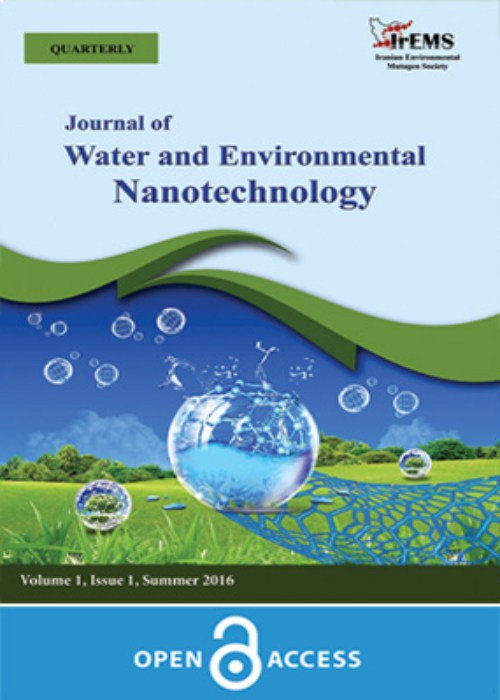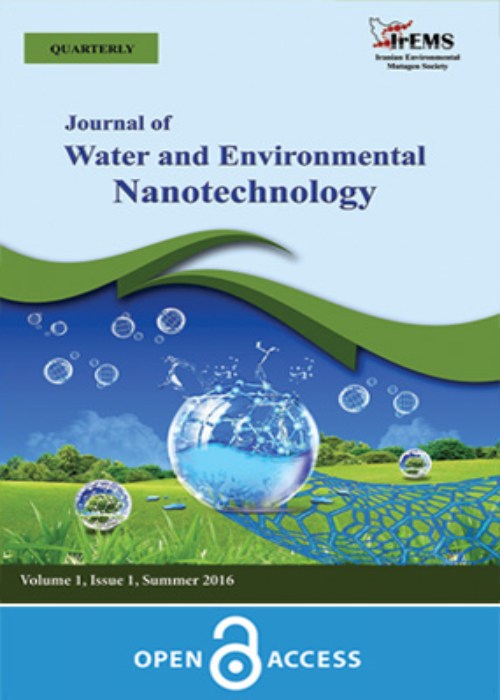فهرست مطالب

Journal of Water and Environmental Nanotechnology
Volume:8 Issue: 2, Spring 2023
- تاریخ انتشار: 1402/03/11
- تعداد عناوین: 8
-
-
Pages 94-107This present study involves the sonochemical and microwave synthesis of an efficient light harvesting nanocomposite photocatalyst, ZnO/GO embedded with copper nanoparticles. The synthesised nanocomposite was characterised by various spectroscopic methods like XRD, SEM, EDX, FT-IR, UV-DRS and fluorescence analysis. The catalytic activity of the synthesised nanocomposite was tested using an organophosphorous pesticide, as the test solution and its percentage efficiency of degradation were studied. About 99 % of 40 ppm of Quinalphos pesticide could be degraded using ZnO/Cu/GO nanocomposite (3 mg/L) under visible light radiation within20 min at neutral pH. The presence of an intrinsic defects and the fluorescence property of the prepared nanocomposite were also detected. The degradation efficiency was estimated by COD and TOC measurements. The reaction rate followed pseudo - first order kinetics with a rate constant of 0.042 min-1. Furthermore, the composite has demonstrated a reusable feature and was utilised for eight cycles without any change in its activity. These findings has illustrated an ecofriendly, more stable and well organised photocatalytic nanocomposite, which could be preferred much for the treatment of industrial and agricultural waste water containing organic contaminants within a short span of time under irradiation using sunlight.Keywords: Quinalphos, photocatalytic mineralisation, Visible light, TOC
-
Pages 108-120In this study, the degradation of azo-dye acid orange 10 has been investigated using Polyvinylpyrrolidone and Brij-35 stabilized iridium oxide nanoclusters as catalysts. Simple chemical reduction method was used to synthesize the above-mentioned nanoclusters. The characteristics of the nanocatalysts were determined by UV-visible spectrophotometer, TEM and XRD. The kinetic study has been carried out at λmax of reaction mixture i.e. 479 nm spectrophotometrically. The degradation follows first order kinetics with respect to oxidant and catalyst concentration while order is one at lower substrate concentration tending towards zero at higher concentration. The degradation kinetics has been supported by the derived rate law. The results showed that Polyvinylpyrrolidone stabilized iridium oxide nanoclusters outperformed Brij-35 stabilized iridium oxide nanoclusters, exhibiting the fastest degradation rate. The progress of the degradation process was monitored by UV-vis spectroscopy. Using Polyvinylpyrrolidone stabilized iridium oxide nanoclusters as a catalyst is a very promising approach for the remediation of acid orange 10 due to the fast degradation rate and high degradation efficiency. In addition, Polyvinylpyrrolidone stabilized iridium oxide nanoclusters can be easily recovered and recycled for three consecutive cycles. It can be inferred from this study that catalytic oxidation methods are active and environment-friendly for the remediation of dyes.Keywords: Degradation, Kinetics, Rate law, Acid orange10
-
Pages 121-136Introduction and Aims
Compounds containing dye are toxic, carcinogenic and mutagenic for aquatic organisms and lead to mutagenicity, carcinogenicity, and dysfunction of human beings’ kidney, liver, brain, reproductive system and central nervous system. Advanced oxidation processes can remove pollutants faster than other processes due to active hydroxyl radical production. This study was aimed at investigating feasibility of dye removal using UVA/TiO2 process.
Materials and methodsThis study was done in a batch reactor and the effects of initial dye concentrations, TiO2 nanoparticles dosage, time, pH and interference compounds on efficiency of dye degradation was investigated. The Daphnia Magna as bioassay test and biodegradability index (BOD5/COD rate) were used for detoxification assessment.
ResultsThe D.Y 50 dye effluent degradation at pH 2, 20 mg/l initial dye concentration and 1 g/l TiO2 catalyst was (lnC0/C= 1.4), (lnC0/C= 3) and (lnC0/C= 2.9) respectively. Dye removal rate by 50 mg/l COD concentration was (88%), Daphnia Magna mortality rate after maximum contact time (96 h) decreased from 96.7% to 43.3% and biodegradability index increased from 0.25 to 0.68.
Keywords: Direct Yellow 50 dye, UV, TiO2, Photodegradation, bioassay, Daphnia magna -
Pages 137-150The purpose of this research is to develop a sustainable and organic energy storage system from oil palm lignin waste-derived Laser Scribed Graphene embedded with molybdenum disulfide (LSG/MoS2). In this study, LSG/MoS2 hybrids were fabricated to overcome the graphene zero band gap, restacking issues of molybdenum disulfide and to induce the electrical conductivity. Therefore, various amounts of LSG (0.1,0.5,1.0 g) were added in MoS2 precursor to produce nanoscale LSG/MoS2 hybrid nanostructure via the hydrothermal method. To justify the findings of LSG/MoS2 hybrid nanostructures, Raman spectroscopy, FESEM, TEM, and XRD were conducted. The D, G and 2D bands found in LSG confirm the formation of graphene from lignin. The morphology of LSG/MoS2 hybrids is porous and has a large surface area anchored with 3D MoS2 nanoflower on LSG. TEM has proved that LSG was wrapped with MoS2, where the presence of lattice spacing of 0.62 and 0.27nm, which corresponded to the (002) and (100) planes of MoS2 was observed. The electrochemical performance of the hybrids was conducted through Electrochemical Impedance Spectroscopy (EIS) demonstrated that increment in LSG in MoS2 precursor effects the impedance and resistances performances.Keywords: Oil palm lignin, Molybdenum disulfide, morphological, structural, Supercapacitor
-
Pages 151-163Nowadays, the water shortage has become a severe issue all over the world, especially in some arid and undeveloped areas. Water is a renewable natural resource that can produce freshwater globally. Interestingly, some animals in nature can collect water from fog, which can be the inspiration to develop novel and functional water-collecting materials. A superhydrophobic surface that utilizes no energy has been synthesized from a water-collecting mechanism of the Stenocara beetles back structures. Firstly, this paper reviews the preparation methods of superhydrophobic surface coatings and then it examines patterns inspired by nature. In this paper, hydrophobic nanocoating was manufactured based on polyurethane (PUR) modified by nano-silica. Silica nanoparticles were synthesized via the sol-gel method. Then, silica nanoparticles were dispersed in polyurethane (PU) coatings. In this article, many factors of collecting moisture are evaluated, for example, temperature, pattern placement angle, pattern shape, types of surface patterns, and ambient humidity. Finally, are introduced the optimum situation for absorbing water from the fog.Keywords: Surface patterns, Nanoparticles of silica, Sol-gel, Stenocara beetles, Fog
-
Pages 164-177The study involved the preparation of CoFe2O4 -CNT nanocomposites through the dispersion of CNT and ferrites into Xylene. Cobalt ferrites were synthesized using a chemical co-precipitation method. The main objective was to investigate the structural, optical and photocatalytic properties of the synthesized nanocomposites using Rose Bengal dye as a model pollutant. Structural analysis was conducted using Transmission Electron Microscopy (TEM) and XRD, confirming the formation of a Single-phase spinal structure of ferrites and nanocomposites with an average particle size of around 25 nm. UV-Vis. spectroscopy and Photoluminescence (PL) were used to study the optical properties of the samples, indicating that the bandgap of the sample is within the visible range, making it suitable for visible light photocatalysis. The band gap shifted to a slightly lower side after the formation of the nanocomposite, and the PL revealed that recombination time increased after the formation of nanocomposites compared to pure CoFe2O4. FTIR spectroscopy confirmed the formation of the spinal structure of ferrites and identified various bonds present in the sample. The photocatalytic activity of the sample showed a significant increase in the dye degradation capacity of ferrites. This increase in photocatalytic activity was consistent with earlier results obtained by PL spectroscopy, which confirmed the formation of a Z-scheme visible light photocatalyst.Keywords: CNT, Nanocomposites, Z-Scheme Photocatalyst, Solar Energy
-
Pages 179-189This study was conducted with the aim of introducing a new sono-Fenton system containing nano-pyrite catalyst and hydrogen peroxide (HP) for the effective removal of tetracycline (TC) from aqueous solutions. The synthesized nano-pyrite was characterized through XRD, FTIR, FE-SEM, and EDX analyses. The best performance of the sono-Fenton nano-pyrite/HP system was observed under the condition of pH 3.0, TC 8.0 mg/L, HP 4.0 mM, ultrasound (US) 40 W, nano-pyrite 1.0 g/L, and 20 min with 93.1% removal efficiency. Comparison of the efficiency of the proposed system components confirmed the remarkable synergy between sono-catalysis and Fenton reactions due to the simultaneous application of nano-pyrite, HP, and US power. Meanwhile, US irradiation caused fluidization, turbulence, mass transfer, and nano-pyrite surface cleaning due to its cavitation and oscillation effects. According to the tracer test, the main agent of TC degradation in the sono-Fenton process was HO^•. The results showed that the TC removal efficiency from the first to the fourth run reached from 93.1% to 70.3%. This means that the recyclability of nano-pyrite has been very successful. Overall, the proposed sono-Fenton system was an efficient and sustainable process for the rapid and effective removal of pharmaceutical contaminants from water and wastewater.Keywords: Hydrogen peroxide, Nano-pyrite, Sono-Fenton, Tetracycline, Ultrasound
-
Pages 190-205The present work reports the synthesis of Cetyl trimethylammonium Bromide (CTAB) assisted CdO nanoparticles with different concentration of CTAB (0.0M, 0.04M, 0.08M and 0.12M) by co-precipitation and their potential application in photocatalysis. X-Ray Diffraction (XRD) results indicate that crystallite size increases as concentration of CTAB is increased. Field Emission Scanning Electron Microscope (FESEM) exhibit that flat sheet-like morphology is changing into thin needle-like structure with concentration of surfactant. Elemental Dispersive X-ray Spectroscopy (EDS) confirmed existence of constituents and hence marks purity of prepared samples. Broad peak of Raman spectra is consisting of three bands from 200-500 cm-1 while Fourier Transform Infrared (FTIR) spectra certifies vibration of Cd and O bond are present at 530 cm-1. Optical Band gap is found to slightly decrease due to addition of CTAB. Dye degradation results showed that CdO nanoparticles can degrade Methylene Blue (MB) dye and Rose Bengal (RB) Dye degrades upto 83% and 85% respectively within 80 minutes of light irradiation.Keywords: coprecipitation, CTAB, Methylene Blue, Photocatalysis


